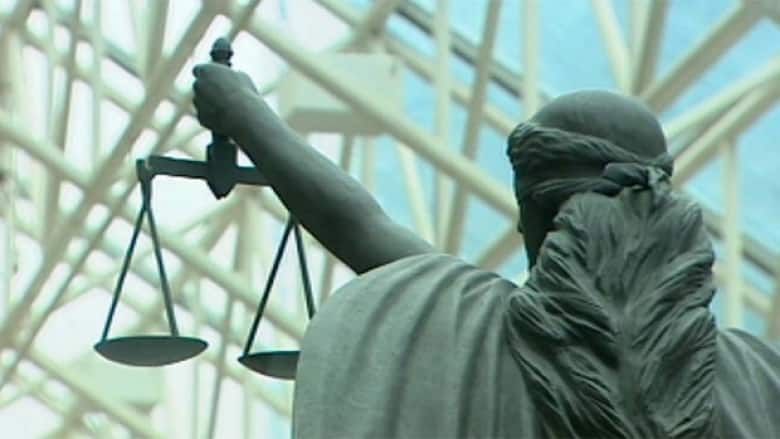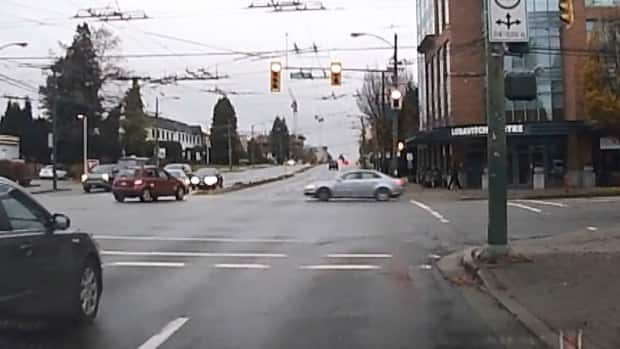[ad_1]
The video is only seconds long. It captures the last moments of Dr. Alphonsus Hui’s life — before Ken Chung’s silver Audi slammed into Hui’s red Suzuki at 119 km/h.
Hui’s daughter acknowledges “the graphic and difficult nature of the video.”
But Monique Hui said she also felt it spoke to the reasons why they believe Chung should be restricted from driving even as he awaits the results of a Crown appeal of a decision to acquit him of dangerous driving causing death.
“We hope that it speaks to the reasons why we need an immediate driving ban for Chung and changes to our legislation regarding excessive speeders with multiple offences,” Hui said in a statement.
“And we hope the demands on our online petition will be met.”
Tougher rules for repeat speeders
Provincial Court judge Gregory Rideout released dash-cam video Monday of a witness to the November 2015 collision on application from three media organizations, including the CBC.
Monique Hui’s online petition — which has now been signed by more than 67,000 people — calls for “new, more stringent legislation and policy” to get repeat excessive speeders off the road.
Dr. Alphonsus Hui, far right, poses for a family photo with daughter Monique, far left, wife Josephine and son Creighton. (Supplied by Monique Hui)
She took up the campaign after Rideout found Chung not guilty last month.
Compounding the issue for the family is news that Chung was charged with a separate excessive speeding offence nearly two years after he collided with Hui.
According to court records obtained by CBC, police caught Chung driving a white Jaguar at 108 km/h — more than twice the speed limit — in the 4400 block of Granville Street at 6:15 p.m. on June 3, 2017.
He was fined $368.
‘That was a green light’
The collision with Hui occurred at the intersection of Oak Street and West 41st Ave. Hui was southound, turning left. Chung was headed northbound in the curb lane of the three-lane road.
Rideout released dash-cam video captured by driver Jimmy Hsieh as he headed eastbound on West 41st.
Dash cam video shows moment of impact
Hsieh’s camera recorded the car in front of him turning right, leaving an unblocked view of the intersection. The car in front of Chung turns right as Chung narrowly misses him, car flying like a bullet into Hui’s vehicle.
Drops of water run down Hsieh’s windscreen in the minutes after, apparently from a fire hydrant knocked out by Hui’s car. The remaining traffic slows as onlookers take in the tragedy.
According to Rideout’s ruling, Hui died of multiple blunt force trauma. A passing cardiologist gave him CPR.
Another drive spoke to Chung who said: “That was a green light.”
Video might spark public debate
In releasing the video, Rideout said the case has seen an outpouring of emotion unparalleled in his 13 years on the bench.
He said he expects more reaction as people see the crash itself.
Dr. Alphonsus Hui was killed in a car crash in Vancouver on Nov. 14, 2015, when he was hit by a speeding vehicle driven by Ken Chung. (Supplied by Monique Hui)
But he also said he hopes the case will lead to a public discussion about excessive speeding, the powerful vehicles a cohort of mostly young men are driving on Vancouver streets and the need for enforcement.
“It was the type of case where it could have gone either way,” Rideout said.
“And that’s why we have reasonable doubt.”
In a set of carefully considered reasons, Rideout explains the legal requirements needed to reach a decision of dangerous driving causing death — as opposed to excessive speeding.
Marked departure versus momentary lapse
The precedent is laid out in a Supreme Court of Canada ruling concerning another B.C. road tragedy: a 2003 head-on collision where the driver of a pick-up truck “for no apparent reason” crossed a solid centre line into the path of an oncoming vehicle, killing all three occupants.
The driver, who had been working in the sun, claimed he must have lost consciousness or fallen asleep.
Canada’s highest court noted the difference between the lower bar for a civil finding of negligence and the high bar needed to make sure an innocent person wasn’t being sent to jail for a “momentary lapse of attention.”

A provincial court judge acquitted Ken Chung of dangerous driving causing death. He said there was reasonable doubt Chung’s driving was a “marked departure” from the standard of reasonable care. (Mike Laanela/CBC)
Two elements of the offence have to be found: the actus reus — the fact the car was speeding or crossing a line — and the mens rea or criminal intent — which should show a “marked departure” from the standard of care a reasonable person would observe in the accused’s circumstances.
Judges don’t consider a driver’s “personal attributes such as age, experience and education.”
Nor can they just say that a reasonable person wouldn’t have been driving like that in the first place.
The evidence showed that Chung travelled the speed limit before accelerating to 139 km/h just a block before the accident. He didn’t run any stop signs. He didn’t swerve into oncoming lanes.
The conditions didn’t require additional caution. And Chung was, in fact, braking at the time he entered the intersection.
Rideout said those factors left doubt as to whether Chung’s actions constituted a “marked departure” from the standard of reasonable care — as opposed to a momentary lapse.
“Critically, I find that the excessive speed was momentary,” the judge wrote.
“I conclude the momentariness of the accused’s conduct in excessively speeding is insufficient to meet the criminal fault component and he must be acquitted.”
[ad_2]




